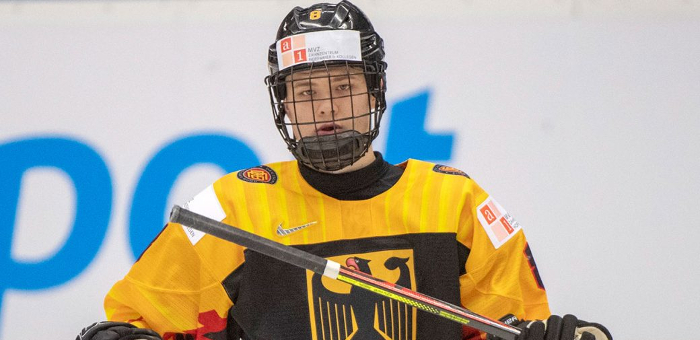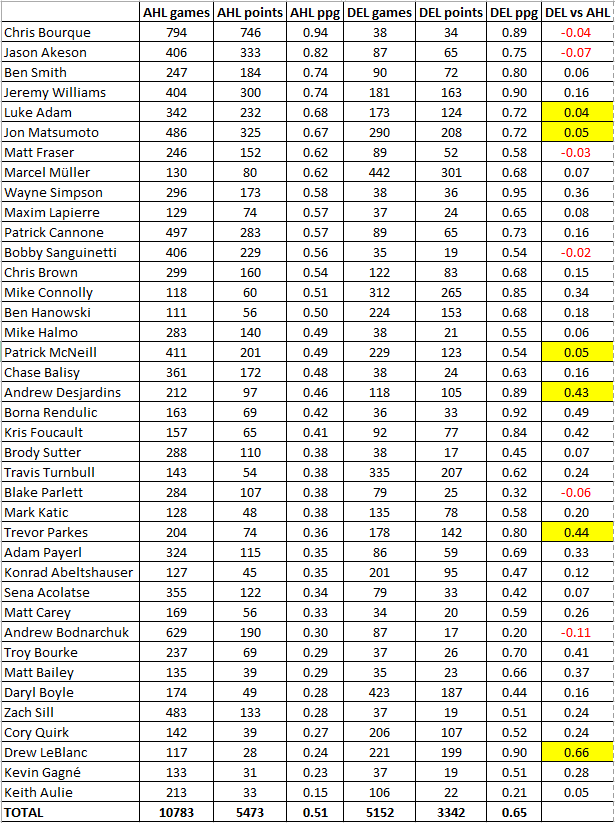Prospect Ramblings: Making Sense of DEL Stats
Jokke Nevalainen
2020-01-21

Tim Stützle, Lukas Reichel and John-Jason Peterka are three 2002-born prospects who are eligible for the 2020 NHL Entry Draft and playing in Deutsche Eishockey Liga (DEL), the top league in Germany.
Stützle seems like a lock for top 10 at this point, and depending on who you ask, Reichel and Peterka are projected to go anywhere from first to third round. All three played very well at the World Junior Championship tournament just a few weeks ago. Stützle and Peterka have also played at the Champions Hockey League where they’ve played against SHL teams among others which has been a good way to see how they stack up against high-end European pro teams. But numbers-wise, their biggest draft year sample will be coming from DEL.
There are very few examples of draft-eligible prospects playing in DEL or even coming from Germany in general, so it’s difficult to know what kind of quality of competition they face there. I’ve heard some people suggest it’s a better league than the Finnish Liiga and I’ve heard some people suggest it’s closer to a beer league than an actual pro league – so opinions are definitely conflicted.
My personal opinion is that it’s slightly below Liiga but clearly above Mestis which is the second-tier league in Finland. I guess I would put DEL and Allsvenskan very closely together to get an idea of what level of league it is.
But to provide more than just my educated guess, I decided to do a statistical analysis. As mentioned, there are so few prospects coming from Germany that we can’t really draw any comparisons from there. But an idea that came to me was to compare DEL numbers to AHL numbers because there are a lot of players currently playing in DEL who have played a significant number of games in the AHL but have been pushed out of there because of their rules that only allow a certain number of veteran players on each team.
I went through DEL’s leading top 100 scorers and checked which ones had played at least 100 games in the AHL. All stats were taken from EliteProspects (as always) on January 19th. I found a total of 39 examples which just shows you how many former AHL players are currently playing in DEL. I know someone could have a much more scientific method but this was the best I could come up on a short notice.
The 39 players had played a total of 10,783 games in the AHL and scored a total of 5,473 points in those games for a points-per-game average of 0.51. Those same 39 players have played a total of 5,152 games in the DEL and scored a total of 3,342 points in those games for a points-per-game average of 0.65.
They had also played a total of 2,008 games in the NHL and scored a total of 363 points in those games for a points-per-game average of 0.18 but I don’t think those NHL numbers are really usable because it’s safe to assume they played a very limited role at that level, so let’s just forget their NHL numbers for now.
So we can see that there is a clear difference; 0.51 in the AHL and 0.65 in the DEL. Out of 39 players, only six have posted a lower points-per-game average in DEL than in the AHL. The AHL is clearly a superior league which shouldn’t surprise anyone. But I was surprised that the difference wasn’t larger than that. If it was just a beer league, then surely those former AHL players could double their points-per-game average pretty easily. But that is not the case; their average only increased 27.8%.
There are a few examples of players increasing their points-per-game average significantly. Andrew Desjardins went from 0.46 to 0.89. Trevor Parkes went from 0.36 to 0.80. And Drew LeBlanc went from 0.24 to 0.90.
But there are also some players who posted a very similar points-per-game average in the AHL and DEL. Luke Adam went from 0.68 to 0.72. Jon Matsumoto went from 0.67 to 0.72. And Patrick McNeill went from 0.49 to 0.54.
All six previously mentioned names have played at least 100 games in both leagues, so I think that sample size is good enough. There are individuals who see a significant increase in their points rate but there are also individuals who remain at a similar level.
One could argue that this is not a fair comparison because players are past their prime when they’re going to DEL but many of the players I used in this comparison were still in their twenties. They’re being paid handsomely in comparison to the Germans they are replacing in that league, so it’s not like they could just slack off either. I’m not going to suggest this is perfect science but I think it’s reliable enough to get some sort of an idea of the quality of competition there.
On the other hand, you could argue that we should exclude everyone’s first AHL season because players usually need some time to adjust there. I don’t have facts for this but I believe their AHL points-per-game average would increase if we did that, and that would bring the two averages closer together. You could also argue that I should have included everyone from DEL, not just the top 100 scorers, because that means I was only looking at players who are doing relatively well in DEL.
So what I’m trying to say is that you could tweak the numbers to either direction which to me is good enough – I’m not a data scientist. If you want to do a more scientific data analysis about this topic, please share the results with me as well. I believe I’ve shared all the details to explain what I did but if someone is willing to put in more effort and/or is better at this thing, then I’d gladly see what those results would look like as well.
If we use the numbers from this exercise and apply them to the points-per-game averages of the young trio right now, here’s what that would look like.
|
Player |
GP |
Pts |
DEL ppg |
AHL equivalence |
|
Tim Stützle |
28 |
27 |
0.96 |
0.75 |
|
Lukas Reichel |
28 |
18 |
0.64 |
0.50 |
|
JJ Peterka |
29 |
10 |
0.34 |
0.27 |
Obviously it would be highly unlikely that these youngsters would have put up those kind of numbers in the AHL because the AHL is a very tough league for teenagers. But I’m not really trying to suggest that either. All I’m trying to say is that their DEL numbers look very good in comparison to some long-time AHL players who are now playing in the same league as them.
Here is the complete table showing all 39 players used in this exercise and their career totals in the AHL and DEL. I highlighted in yellow the six examples I used above.

If you think all of this was hogwash, I would like to share two additional examples of players moving the opposite direction. Dominik Kahun (CHI) put up 41 points in 42 games during his final season in DEL, and then moved on to score 37 points in 82 games in the NHL the next season. And Moritz Seider (DET) put up six points in 29 games in DEL last season, and this season he has 15 points in 33 AHL games. So there are some examples of young players doing pretty well after moving from DEL to North America.
Don’t sleep on Deutschland.
*
And that’s all for now, thanks for reading. Remember to follow me on Twitter @JokkeNevalainen.
Main picture courtesy of sportsnet.ca






